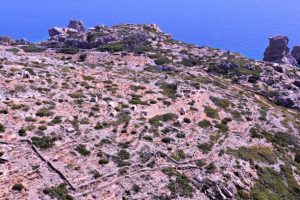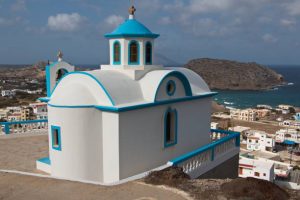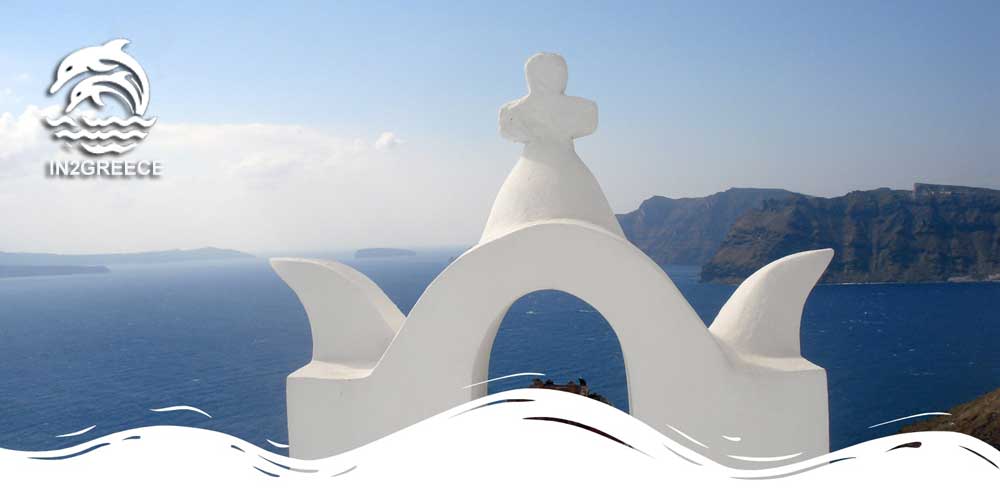Karpathos sightseeing

Also worth visiting is Sokastro: once an island of its own, it now has the form of a peninsula bearing some important remains of Byzantine and Medieval origin. Tradition has it that this was the headquarters of naval operations of the Byzantine Emperor Nikiforos Phokas (AD 602 – 610) at the time of his struggle to push the Arabs off Crete.
In Menetes: interesting collection of archaeological findings, pottery, sculptures and icons from the area.
At Olympos: remains of the ancient settlement of Vrykous, once one of Karpathos’ most important towns that saw times of glory in as early as the 5th century BC.
There can still be seen remains of house walls and foundations dating from the 4th and 3d centuries BC. A minor collection of archaeological findings can be seen at Vrykous, site of the temple to Lindia Athena (Athena of Lindos).
Fortresses
At Arkasa: the Fort of Palaeokastro, harboring vestiges covering a long historical period, from ancient times through to the era of the Venetian and later on the Ottoman Rule. Those willing to sweat the steep climb uphill are certain to be rewarded by the view from the top. Archaeologists estimate this is the site where once stood the temple dedicated to Lindia Athena.
At Pigadia, it is worth visiting the remains of the church of Saint Photini, an early christian basilica dating from the times between the 5th and 6th centuries AC, at a location known as “Aphoti”, on the coast. Amongst the many interesting findings unearthed by archaeologists, there is a marble, Corinthian style column capital and a marble tomb stele confirming estimates that the basilica stood on the site of what had in even older times been a shrine dedicated to the Dioscouri.
Churches

At Aperi, the church of Aghios Gheorghios (St. George), at a location known as “Vatses”.
The church of Kyra Panaghia (Virgin Mary), situated on a site of rare scenic beauty, overlooking the sea, within the settlement bearing the same name.
At Diafani: the churches of Aghios Nikolao, Zoodohos Pigi and Aghios Vassilios, their cupolas typically set in red ceramic tiles in the Byzantine style.
At Lefkos: the church of Aghios Georghios, dating from the 13th century; remains of interesting – though largely faded – frescos.
At Menetes: The church of Kimissis tis Theotokou (The Dormition), built in the 19th century, by far Karpathos’ most celebrated church. Some of the pillars used for the construction of this church were taken from the early christian basilica of Aghia Anastasia, in Arkasa.
Also worth visiting are the small churches of Aghios Mamas and Aghios Antonios, with some interesting frescos.
At Mesochori: the church of Aghios Ioannis Prodromos (St. John the Baptist), featuring frescos from 1781 and a wood-sculpted icon screen.
The Church of Panaghia Vryssiani: featuring a cross-form cupola and a lace-like ornamented belfry in front.
Vestiges of the Byzantine Church of Aghia Irene, featuring some interesting although weather-battered frescos. Six to seven steps down will bring you to the sanctuary, the sole part of the church still standing, the rest of the church being buried under the sands. Access: by boat. .
At the village of Othos: the church of the Dormition (17th century)
At Olympos: church of the Virgin Mary (16th century), featuring a wood-sculpted icon screen and beautiful frescos.
The churches of Chryssovalantou, Aghios Onouprhios and Aghia Triada (Trinity).
The church of Aghios Ioannis at an 1 ½ hour’s walk from the village of Avlona. This site of rare scenic beauty is truly worth the walking.
At Marmara, near the village of Arkassa, the early christian basilica of Aghia Sofia, once referred to as the church of Aghia Anastassia.
